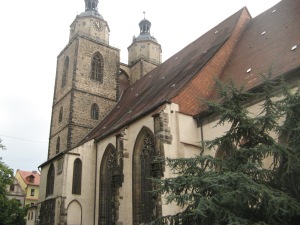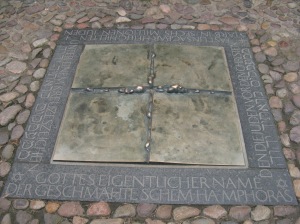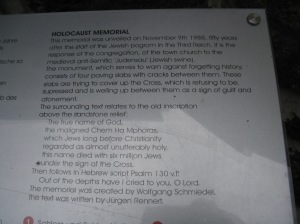After we visited tower church and took our pictures in front of Martin Luther’s statue (albeit under scaffolding) we carried on further into the town to look at the parish church of St. Mary, where Martin Luther preached much of the time.
Wandering around the building outside to look at the architecture and items of interest, here is something I did not expect to see.
At the back, carved below the roof and chimney, as if an afterthought to the official architecture and design of the church exterior, is a small relief sculpture depicting pigs and Jews; clearly an anti-Semitic insult.
My heart is sickened as I look on this strange fresco dated from 1305. Who would have thought to put such a thing on a church whose founder, Jesus Christ, was Jewish?
Apparently this “Judensau,” found in other locales in Europe and dating from the Middle ages, is one of the surviving examples of a form of degenerate folk art depicting Jews and pigs.
As a 21st century Christian, I wonder what was going through people’s heads back in those days. It’s impossible to say, so I can only speculate. Besides being evidence of the darkness of human hearts, were these prejudices a backlash for the persecution of early Christians? Was this insulting relief and others like it an ill thought out re-iteration of Biblical judgement on those who reject Jesus as Messiah? Or was it simply an “us” and “them” mentality brought about by ignorance of people who were largely illiterate and whose access to Scripture was limited by the fact that the printing press wasn’t yet invented?
I don’t know, but curious as I am to understand, if I were to dive into the “why” of historic anti-Semitism, I would be opening centuries of disgusting worms and that would go way beyond the scope of this blog post.
I can only say that over history, there are things the church as an institution, and individuals who claim to be part of the church, have got wrong.
Hatred was never what Jesus intended.
But there is good news in this case: Eventually there was acknowledgement of the wrongs of the past. The fresco has been left intact, probably for historical purposes, but imbedded in the cobblestones below is a new plaque, a response from the congregation, installed in 1988. Between four tiles, a molten substance like gold, presses up – the cross of Christ, a sign of guilt and atonement.
The inscription around the plaque reads: “The true name of God, the maligned Chem Ha Mphoras, which Jews long before Christianity regarded as almost unutterable holy, this name died with six million Jews, under the sign of the Cross.”
The apology took a long time, but light has been cast on Wittenberg’s dark secret. Unlike their forbears, this congregation got it right.



